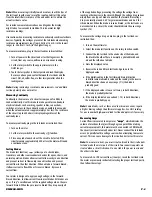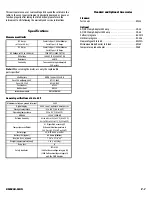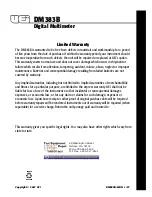
Tro u b l e s h o o t i n g
DM383B-MAN
P. 6
If I See This
Malfunction
Instrument does not
turn on
Instrument turns on
but LCD indicates
some unreasonable or
unchanging value
A value appears on
screen with no input
applied
A known value is not
displayed on the LCD
when measured
Meter reading
is unstable
No audible tone
with near zero
resistance value
Amps readings do
not work
I Should
Check For
Battery voltage
On/Off switch
position
MAX button pressed
HOLD button pressed
Stray voltage
MAX and HOLD
buttons pressed
Bad test lead connections
Defective test leads
Battery voltage
Offset rotary
selector knob
Bad test lead contacts
Improper selector position
Proper switch position
Proper test lead
port position
Blown fuse
Then Take This Corrective
Action
Replace low battery
Ensure button moves freely
and is in the on position
Look for MAX HOLD icons
displayed on the LCD
-Turn off one or
both buttons
Short test leads together -
If a value near 000 appears,
instrument is OK
Move meter and leads away
from devices that create
electrical fields
Turn off one or both buttons
(check for icons on LCD)
Ensure test leads are fully
inserted and free of
corrosion or dirt
Short test leads together in
the 400 ohm scale - Expect
less than .5
Ω
Replace low battery
Ensure knob is firmly placed
in switch position
Ensure there is no insulating
material, dirt or debris at
contact points
Tone sounds only in
continuity mode. Place
selector in position
Ensure switch is in proper
AC or DC amps position
(ACA or DCA)
Ensure the red test lead is
plugged into the appropriate
amps port
Replace blown fuse
1
2
3
Fuse Replacement
WARNING!
Disconnect the test leads from the circuit under test and from the meter
prior to removing or installing fuses! Replace the bottom fuse with the
fuse specified for this meter ONLY!
To replace a blown fuse, perform the following procedures:
1. Turn off the meter.
2. Remove the rubber boot from the meter, starting at the top.
3. Place meter face down on a clean cloth.
4. Remove the screws from the rear case. Two machined screws
fasten the bottom and two self-tapping screws fasten the top.
5. Separate the two halves.
6. Lift the entire printed circuit board (PCB) housing up and away from
the front half of the meter. Lift the PCB housing straight up as there
are metal cylinders inside the test lead insulators that must slide
out with it.
7. Turn the housing over to expose the fuses.
8. Check to ensure the fuse is bad by confirming that there is no
c o n t i n u i ty between the metal ca p s .
Note:
If the fuse is good, check for corrosion at the fuse clips and
ensure clips are tight around the fuse.
9. Insert a new fuse, or reinsert the good one.
10. Reassemble the meter.
View of PCB housing face-up with cover off.
1. P CB
2. 12A, 250V Fu s e
3. 0.5A, 660V Fu s e



























